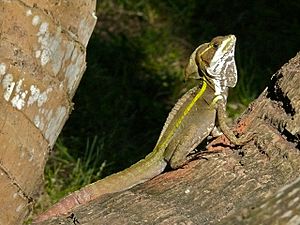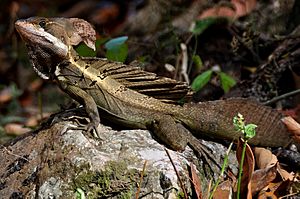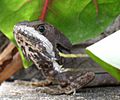Brown basilisk facts for kids
Quick facts for kids Brown basilisk |
|
|---|---|
 |
|
| Conservation status | |
| Scientific classification |
The brown basilisk (Basiliscus vittatus) is a fascinating lizard. People also call it the striped basilisk or common basilisk. It's famous for its amazing ability to "walk on water"!
This lizard lives naturally in Mexico, Central America, and parts of Colombia. You can also find them in Florida, USA, where they were introduced. Brown basilisks have special big back feet with skin flaps. These flaps help them run super fast across the surface of water.
Contents
About the Brown Basilisk
What Do Brown Basilisks Look Like?
Male brown basilisks can grow up to about 2 feet (61 cm) long, including their tail. Females are a bit smaller. These lizards have a cool crest, which is like a fin, in three parts. It runs from their head, along their back, and down their tail.
Their skin is usually brown or olive brown. They have black stripes across their sides and on their crest. A white stripe also runs from their eyes all the way to their back legs. Males have a much bigger crest than females.
A brown basilisk usually weighs between 0.4 and 1.3 pounds (200–600 grams). They have long toes with sharp claws, which help them climb.
The Name "Basilisk"
Where Did the Name Come From?
The name Basiliscus comes from an old Greek mythology story. In these myths, a "basilisk" was a scary creature. It was said to be part rooster, part snake, and part lion. People believed it could turn someone to stone just by looking at them!
The Greek word basilískos means "little king." This name was given to the lizard by Carl Linnaeus in his famous book, Systema Naturae.
Running on Water
How Do Basilisks Walk on Water?
Smaller brown basilisks can run about 30 to 65 feet (10–20 meters) across water without sinking! Younger basilisks can often run farther than older ones.
When a basilisk feels in danger, it runs very quickly over a river or lake. The special flaps on its back feet open up. This creates a larger surface area, helping the lizard stay on top of the water. It's like they're running on tiptoes across the surface!
Brown Basilisk Behavior
Daily Life of a Basilisk
Brown basilisks are related to iguanas. Like most reptiles, they are active during the day. They spend their time hunting for food and staying safe.
Their brown and olive colors help them blend in perfectly with their surroundings. This amazing camouflage makes them very hard to spot when they stay still. In the wild, a brown basilisk might live for about 7 to 8 years. However, many don't live that long due to dangers.
Reproduction
Baby Basilisks
Female brown basilisks are busy mothers! They can lay eggs five to eight times each year. Each time, they lay about 2 to 18 eggs.
After about three months, the eggs hatch. The baby basilisks are very tiny when they are born, weighing only about 0.07 ounces (2 grams).
Gallery
-
In Florida, United States
See also
 In Spanish: Basilisco marrón para niños
In Spanish: Basilisco marrón para niños






